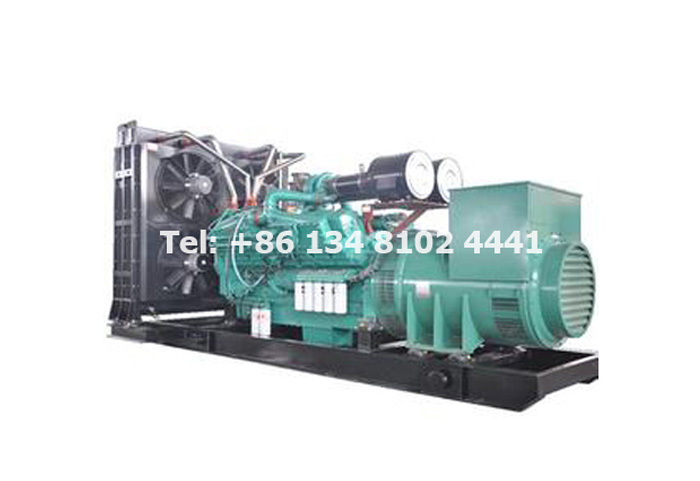Diesel generators are backup equipment to ensure the provision of electrical energy after power outages. Daily maintenance can improve the service life of the generator. The maintenance of diesel generators is divided into weekly maintenance work, monthly maintenance work and annual maintenance work.
Let's learn more about the maintenance and maintenance procedures of diesel generators .
1. Weekly maintenance work
1. Check the oil level of the oil, the oil level should be kept between the upper and lower scales of the dipstick, and add the same type of oil if necessary.
2. Check the amount of diesel oil, slag discharge from the fuel tank, water discharge, and leak detection. The added diesel oil needs to be precipitated for 24 hours.
3. Check the coolant level. The liquid level should be maintained at about 5 cm under the neck of the tank cover, and distilled water should be added as necessary.
4. Check whether the coolant heater is working (please check in winter).
5. Check the air filter indicator. If there is a red mark, please replace the filter element or replace the filter element.
6. Check the battery charging voltage (only for automatic units), the normal charging voltage of a 12-volt battery is about 14 volts, and the normal charging voltage of a 24-volt battery is about 27 volts.
7. Clean the unit.
2. Monthly maintenance work
The generator set should run on load for at least 30 minutes per month. The boot steps and inspection items are as follows:
Before the generator set starts
1. Check the items in your weekly work, plus the following items.
2. Check the surrounding environment of the unit. The oil engine room should be kept well lit, the air should be circulated and clean, and debris should not be piled up, and noise reduction measures should be adopted in accordance with environmental protection requirements so as not to affect the normal operation of the unit.
3. Check whether the air inlet and exhaust channels and smoke exhaust pipes of the unit are clogged.
4. Ring machine inspection: Check whether there is waste stuck in the radiator or engine, or whether there are loose or falling bolts and shrouds, and tighten and repair if necessary.

5. Check whether the fan belt is too loose and worn, and adjust or replace it if necessary.
6. Check the condition of each instrument, the instrument should be complete and in good condition, and the instructions are accurate. If damage is found, please replace or repair it.
7. Check whether the wiring of the generator and control screen is loose.
8. Whether the cooling water, lubricating oil and diesel oil reach the specified liquid level.
9. Check the generator set for water leakage, oil leakage, air leakage, and electricity leakage.
After the generator set starts
1. The unit should work stably and operate normally.
2. Check the oil pressure gauge: the normal working pressure is generally between 3 and 6.5 Bar, the oil pressure value of small units is generally slightly lower, and the oil pressure value of large units is generally slightly higher. According to the seasonal conditions in different regions, choose lubricants of different viscosities.
3. Check the water thermometer: the water temperature depends on the ambient temperature and the size of the load, and it should generally be kept between 70 and 90 degrees.
4. Check the charging voltmeter: the charging voltage is generally about 2-3v higher than the battery voltage.
5. Check the AC frequency.
6. Check the AC voltage.
Further reading:7. Check the AC current.
8. Ring the machine to check the noise and leakage of the unit, and stop for maintenance if necessary.
9. Check whether the cylinder is working, the cooling water circulation and the exhaust color are normal, and stop for inspection if necessary.
diesel generator set shutdown
The shutdown of the unit is divided into two situations: normal shutdown and emergency shutdown.:
1. Normal shutdown: first cut off the load, and then shut down after 5 minutes of no-load operation.
2. Emergency shutdown: When the operation of the unit is dangerous and faulty, it will be shut down immediately.
Emergency shutdown should be carried out when the following situations occur:
(1) Speed failure.
(2) The oil circuit is blocked or the water temperature is too high (100 degrees Celsius)
(3) There is an abnormal noise, the flywheel is loose or the transmission mechanism fails.
(4) The pointer of the oil pressure gauge suddenly drops.
After the generator set is shut down
1. Check whether the automatic switch (only for the automatic unit) is in the desired position.
2. Check the amount of oil in the diesel tank and fill it up if necessary.
3. Check the fault display and repair when necessary.
4. Add lubricating oil to parts other than the self-circulation system.
5. Make operating records and clean the computer room and equipment.
6. Prepare for the next boot.
3. Work every year (must be handled by experienced technicians)
1. Check the items in your weekly work, plus the following items.
2. Replace the fuel filter and release the fuel tank slag.
3. Crankcase respirator cleaning.
4. Check the valve clearance and adjust if necessary.
5. Inspect and test the engine protection system.
6. Check whether the electric ball is damp, clean up the internal dust and debris, use a shaking meter to check and record the insulation of each winding, and fill the bearing with grease.
7. Conduct a load test, run with a minimum of 30% load for 2 hours, and record each data.
After the load test is completed, replace the oil and oil filter.

Comments
0